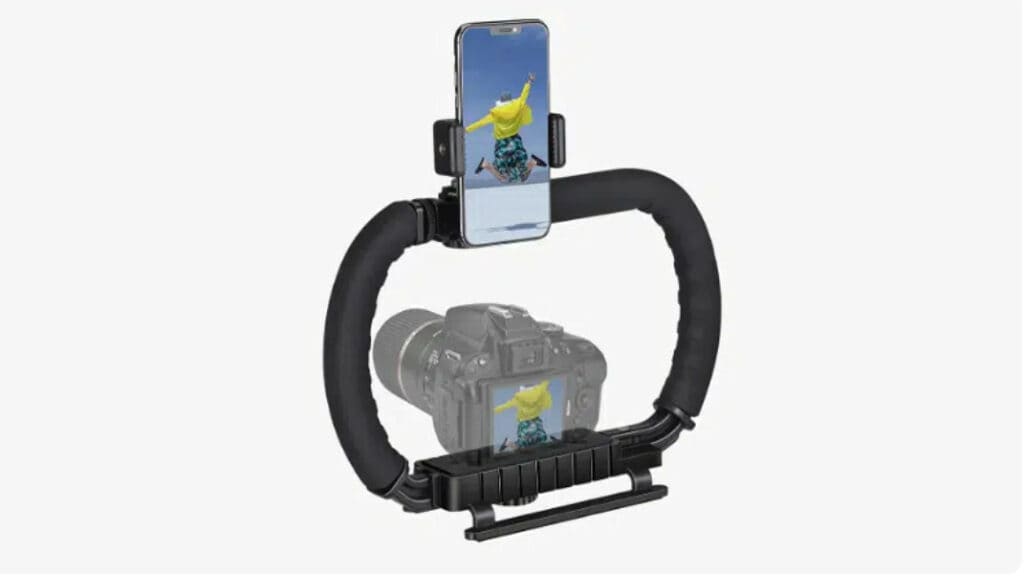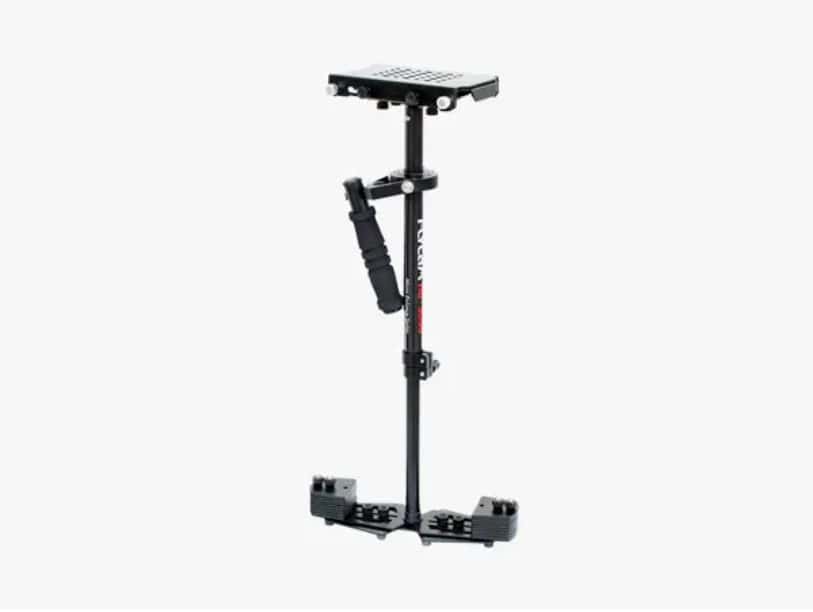
Fantaseal DSLR Camera Camcorder

Roxant Pro Video Camera Stabilizer

Camera Stabilizer FLYCAM HD-3000
A good gimbal is undoubtedly one of the best tools for anyone shooting on the go. These self-stabilization devices come in various sizes and shapes, with variants designed for cell phones, lightweight DSLRs, film cameras, and everything in between.
Let’s look at some of the best low-cost gimbals on the market and see which one is right for you.
Top 5 Best Affordable Stabilizers For DSLR Cameras
Considerations When Purchasing DSLR Stabilizers
Not everyone uses the same cameras and equipment or has the same purpose. That being said, no matter what camera you’re using, there are a few things to consider when selecting a gimbal.
Here are a few things to remember.
Body mass index:
The more you carry, the heavier the gimbal (and the camera). Most camera stabilizers are lightweight, but some can weigh as much as 10 pounds and possibly as much as 13 or 14 pounds with the camera attached.
Balance:
The balance of a camera stabilizer is equally essential, if not more so than its weight. Compensation is determined by how well your camera balances and how easy it is to balance. A balanced stabilizer will be easy to use and make your job easier.
Battery:
While some low-cost gimbals do not require batteries, most models do to power the brushless motors. Some gimbal stabilizers use conventional alkaline batteries, while most devices use lithium-ion batteries.
Adaptability:
Unlike gimbals built for smartphones or action cameras, DSLR gimbal stabilizers must be versatile enough to accept cameras of various sizes and diverse shooting methods. The best gimbal stabilizers can be configured in multiple ways to support different shooting styles.
Price:
The cost of a gimbal stabilizer might vary considerably. Most models cost a few hundred dollars; however, gimbals can cost as much as $500 or more. Higher-priced gimbals are more likely to have advanced functions and come with more extended warranties.
The Best Affordable DSLR Stabilizers
Here is the list of the best affordable DSLR stabilizers you can buy for amazing results.
1. Fantaseal DSLR Camera Camcorder
It is a two-handed hydra stabilizer suitable for indoor and outdoor professional videography. This lightweight stabilizer is ideal for capturing low-angle action such as skateboarding, snowboarding, and boating.
With about 15 ounces, you can attach a camera, a smartphone, or both and capture images while holding the fully ergonomic grip. You may be confident that you will not strain your hands no matter how long you want to shoot.
The small ball head hot shot is helpful for various video-making gear. For example, you can install microphones and LED flashlights in any location that works best for you.
The payload of this stabilizer is relatively low due to its size, which is a minor disadvantage. So, if you have a heavy and professional camera, you should choose more durable equipment.
However, if you’re a newbie or a hobbyist trying to increase the quality of your video production, the Fantaseal DSLR Hydra Stabilizer is for you. Look no further if you need something portable for modest video projects using your phone or camera.
Features
- 0.9 pounds in weight
- It is compatible with many cell phones, DSLR cameras, and camcorders.
- Rubberized grip with a solid ergonomic grip
- Adaptable accessory attachment
2. Roxant Pro Video Camera Stabilizer
Because the Roxant Pro Video Camera Stabilizer and the Neewer Adjustable Stabilizer are similarly priced, the two gimbals attract comparison. And the Roxant Pro Video always comes out on top. To begin with, the Roxant Pro weighs less than two pounds, making it much easier to manage for extended periods.
The comfort grip handle is far superior to Neewer’s plain foam handle. The Roxant Pro has superb balance, and it comes with a lifetime warranty. This is the best gimbal stabilizer on Amazon because it provides reliable performance at an affordable price.
However, this gimbal has one fundamental flaw: it cannot support huge cameras.
While the Roxant Pro is ideal for an action camera, it isn’t designed for anything heavier than two pounds, so if you have a mirrorless camera like the Sony a6500 or an entry-level DSLR with a prime lens, you’ll be alright.
Features
- 0.83 kg in weight (1.83 lbs)
- Payload Maximum: 0.95 kg (2.1 lbs)
- Stabilizer mechanical
- Compatible with GoPros, smartphones, point-and-shoot cameras, DSLRs, and video cameras.
3. Camera Stabilizer FLYCAM HD-3000
Although the FlyCam HD-3000 24″ Handheld Stabilizer looks a lot like the Neewer 24″ Handheld Stabilizer, there are a few key distinctions. This higher-quality gimbal with a changeable three-axis plate lets you modify the pan and tilt without touching the camera.
The Flycam HD-3000, like the Neewer gimbal, is entirely mechanical, with the three-axis gimbal adjusted by moving a cushioned handle. Many counterweights on the bottom allow for easy vertical balance adjustment, supporting both bigger, professional-quality cameras and smaller ones.
However, this gimbal is most likely better suited for standard film-industry cameras rather than smaller handheld ones. The Flycam is constructed of solid aluminum, making it extremely sturdy. Unfortunately, this also adds to its weight.
With just under nine pounds, this isn’t likely to fit in your pocket and is more suited for extensive film sessions than fast films. This is a tough, high-quality gimbal, but its bulk means it’s not for everyone. It is primarily intended for usage with lightweight cameras such as vlogging cameras or smaller DSLRs.
Features
- 3.99 kg in weight (8.8 lbs)
- 3.5 kg is the maximum payload (7.7 lbs)
- Stabilizer mechanical
- DV, HDV, and DSLR video cameras are all compatible.
4. Camera Gimbal Stabilizer FeiyuTech G6 Max
The FeiyuTech G6 Max is a significant advancement, with Bluetooth connectivity to your smartphone and clever adaption technology that automatically adjusts to different cameras. It’s an improvement over the G6 Plus. It weighs only 1.5 pounds and contains the features that make this gimbal an excellent choice.
The G6 is compatible with a variety of pocket video and action cameras, mirrorless cameras with short lenses, and smartphones, making it one of the most adaptable gimbals on the market. Despite its small size, the G6 has a maximum payload of 1.2 kg (2.64 pounds.)
The gimbal has automated rotation and shutter control features, making time-lapse shooting more manageable and professional. The “Magic Focus Ring” allows you to manipulate three-axis rotation, zoom, focus, and parameters like IS0, WB, and exposure value.
A clever three-axis design enables 360-degree vertical and horizontal rotation. You may control the gimbal by Bluetooth from your smartphone, or you can use the specialized Magic Focus Ring. The G6 Max’s structure is also highly customizable.
The model includes four modes: Horizontal Follow, which locks the tilt access; Tilt Follow, which allows you to utilize the tilt and panning options simultaneously; and All Follow, which combines the last three. If the payload is 600 grams, the battery will last around 9 hours on a single charge.
It includes a USB-C charging cable. The only issue with the gimbal is that the Inception mode causes some cameras to hit the gimbal’s edge. As a result, it is best suited for APS-C cameras and lower.
Features
- 1.5 kg in weight (3.3 lbs)
- 1.2 kg is the maximum payload (2.64 lbs)
- 9-hour battery life
- Suitable for APS-C and smaller cameras
5. Zhiyun Crane M3 – Compact, Lightweight, Mirrorless Gimbal
The Zhiyun Crane M3 is another lightweight gimbal stabilizer ideal for adventure and landscape photography. You may attach your camera to the quick-release plate and move around like you’re holding a water bottle, as it weighs only 2.2 pounds. The appealing appearance and comfortable grip are a plus.
It has a touchscreen interface similar to smartphones, allowing you to control the camera movement and select between shooting settings. Vortex, timelapse, and panorama modes are all supported.
It is adaptable and can be used to film with cameras of various sizes. There’s also an LED fill light and temperature and brightness adjustments.
This aids in image noise management and further defines the sharpness of the produced video. It also means that this gimbal stabilizer is ideal for on-the-go shooting without the risk of blur.
The camera movement on the Zhiyun Crane M3 gimbal stabilizer is best described as fluid. As you go, you may easily adjust the joystick near the upper section of the stabilizer with your thumb.
Enjoy the powerful battery capacity of 1150mAh, which requires only 2 hours to charge fully and may last up to 8 hours. If necessary, you can set the stabilizer while working with a power bank, but this may interfere with the fluidity and stealth that Zhiyun Crane is designed to give.
Features
- 2.2 pounds in weight
- Supports many Sony, Canon, Nikon, FUJIFILM, Panasonic, Sigma, and GoPro Hero camera models.
- Interface with a touchscreen
- 8-hour battery life
- Mirrorless and DSLR cameras, as well as cell phones, are all compatible.
Conclusion
A gimbal is a way to go if you want to up your filmmaking game. Your filmed material will look better and more professional, allowing your films to stand out from the crowd.


